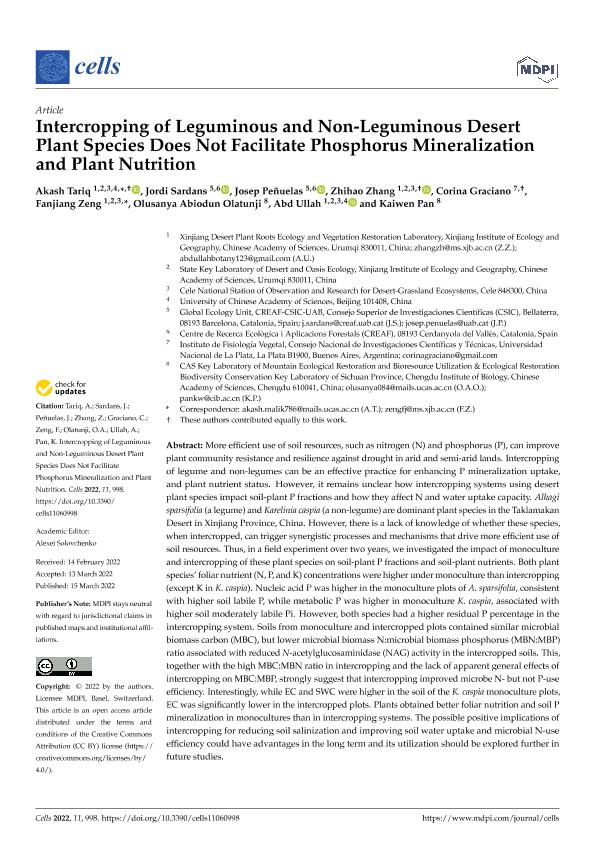Mostrar el registro sencillo del ítem
dc.contributor.author
Tariq, Akash
dc.contributor.author
Sardans, Jordi
dc.contributor.author
Peñuelas, Josep

dc.contributor.author
Zhang, Zhihao
dc.contributor.author
Graciano, Corina

dc.contributor.author
Zeng, Fanjiang
dc.contributor.author
Olatunji, Olusanya Abiodun
dc.contributor.author
Ullah, Abd
dc.contributor.author
Pan, Kaiwen
dc.date.available
2023-08-29T13:18:32Z
dc.date.issued
2022-03
dc.identifier.citation
Tariq, Akash; Sardans, Jordi; Peñuelas, Josep; Zhang, Zhihao; Graciano, Corina; et al.; Intercropping of Leguminous and Non-Leguminous Desert Plant Species Does Not Facilitate Phosphorus Mineralization and Plant Nutrition; MDPI; Cells; 11; 6; 3-2022; 1-23
dc.identifier.issn
2073-4409
dc.identifier.uri
http://hdl.handle.net/11336/209693
dc.description.abstract
More efficient use of soil resources, such as nitrogen (N) and phosphorus (P), can improve plant community resistance and resilience against drought in arid and semi-arid lands. Intercropping of legume and non-legumes can be an effective practice for enhancing P mineralization uptake, and plant nutrient status. However, it remains unclear how intercropping systems using desert plant species impact soil-plant P fractions and how they affect N and water uptake capacity. Alhagi sparsifolia (a legume) and Karelinia caspia (a non-legume) are dominant plant species in the Taklamakan Desert in Xinjiang Province, China. However, there is a lack of knowledge of whether these species, when intercropped, can trigger synergistic processes and mechanisms that drive more efficient use of soil resources. Thus, in a field experiment over two years, we investigated the impact of monoculture and intercropping of these plant species on soil-plant P fractions and soil-plant nutrients. Both plant species’ foliar nutrient (N, P, and K) concentrations were higher under monoculture than intercropping (except K in K. caspia). Nucleic acid P was higher in the monoculture plots of A. sparsifolia, consistent with higher soil labile P, while metabolic P was higher in monoculture K. caspia, associated with higher soil moderately labile Pi. However, both species had a higher residual P percentage in the intercropping system. Soils from monoculture and intercropped plots contained similar microbial biomass carbon (MBC), but lower microbial biomass N:microbial biomass phosphorus (MBN:MBP) ratio associated with reduced N-acetylglucosaminidase (NAG) activity in the intercropped soils. This, together with the high MBC:MBN ratio in intercropping and the lack of apparent general effects of intercropping on MBC:MBP, strongly suggest that intercropping improved microbe N-but not P-use efficiency. Interestingly, while EC and SWC were higher in the soil of the K. caspia monoculture plots, EC was significantly lower in the intercropped plots. Plants obtained better foliar nutrition and soil P mineralization in monocultures than in intercropping systems. The possible positive implications of intercropping for reducing soil salinization and improving soil water uptake and microbial N-use efficiency could have advantages in the long term and its utilization should be explored further in future studies.
dc.format
application/pdf
dc.language.iso
eng
dc.publisher
MDPI
dc.rights
info:eu-repo/semantics/openAccess
dc.rights.uri
https://creativecommons.org/licenses/by/2.5/ar/
dc.subject
ARIDITY
dc.subject
COMPETITION
dc.subject
DROUGHT
dc.subject
NITROGEN
dc.subject
NITROGEN FIXATION
dc.subject
PHOSPHORUS
dc.subject.classification
Agricultura

dc.subject.classification
Agricultura, Silvicultura y Pesca

dc.subject.classification
CIENCIAS AGRÍCOLAS

dc.title
Intercropping of Leguminous and Non-Leguminous Desert Plant Species Does Not Facilitate Phosphorus Mineralization and Plant Nutrition
dc.type
info:eu-repo/semantics/article
dc.type
info:ar-repo/semantics/artículo
dc.type
info:eu-repo/semantics/publishedVersion
dc.date.updated
2023-07-07T21:39:45Z
dc.journal.volume
11
dc.journal.number
6
dc.journal.pagination
1-23
dc.journal.pais
Suiza

dc.journal.ciudad
Basel
dc.description.fil
Fil: Tariq, Akash. Chinese Academy of Sciences; República de China
dc.description.fil
Fil: Sardans, Jordi. Universidad de Barcelona; España
dc.description.fil
Fil: Peñuelas, Josep. Universidad de Barcelona; España
dc.description.fil
Fil: Zhang, Zhihao. Chinese Academy of Sciences; República de China
dc.description.fil
Fil: Graciano, Corina. Consejo Nacional de Investigaciones Científicas y Técnicas. Centro Científico Tecnológico Conicet - La Plata. Instituto de Fisiología Vegetal. Universidad Nacional de La Plata. Facultad de Ciencias Naturales y Museo. Instituto de Fisiología Vegetal; Argentina
dc.description.fil
Fil: Zeng, Fanjiang. Chinese Academy of Sciences; República de China
dc.description.fil
Fil: Olatunji, Olusanya Abiodun. Chinese Academy of Sciences; República de China
dc.description.fil
Fil: Ullah, Abd. Chinese Academy of Sciences; República de China
dc.description.fil
Fil: Pan, Kaiwen. Chinese Academy of Sciences; República de China
dc.journal.title
Cells
dc.relation.alternativeid
info:eu-repo/semantics/altIdentifier/url/https://www.mdpi.com/2073-4409/11/6/998
dc.relation.alternativeid
info:eu-repo/semantics/altIdentifier/doi/http://dx.doi.org/10.3390/cells11060998
Archivos asociados
